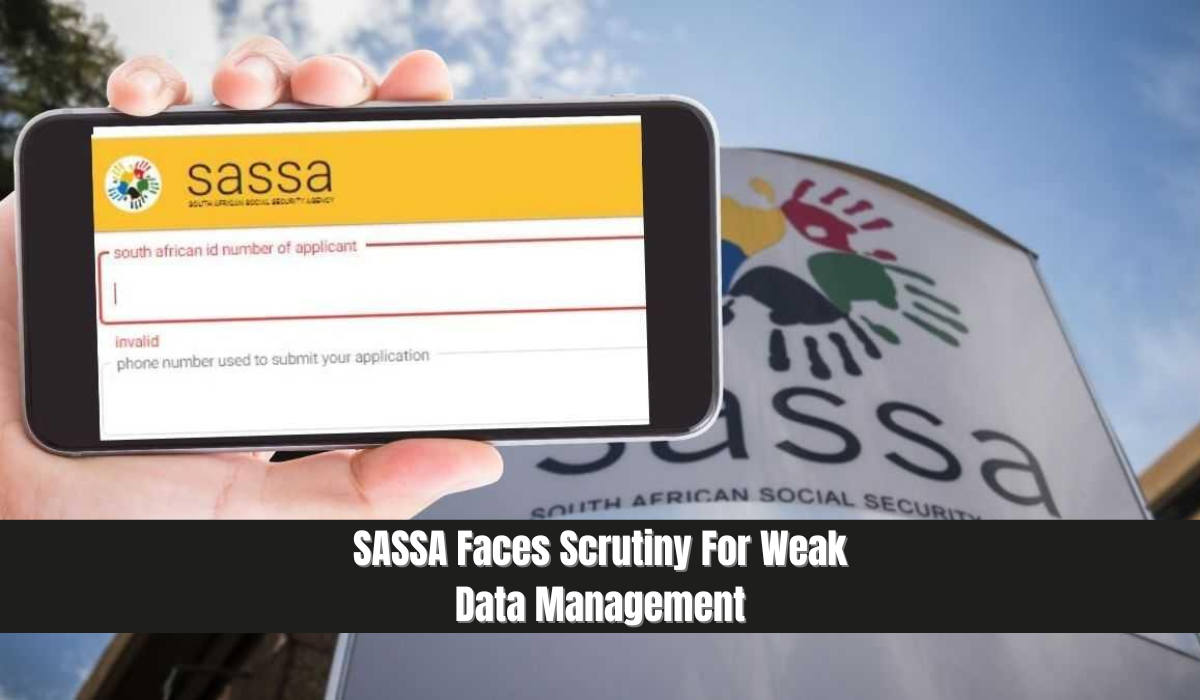SASSA Faces Scrutiny For Weak Data Management

SASSA Faces Scrutiny For Weak Data Management. The South African Social Security Agency (SASSA) is under intense scrutiny due to significant weaknesses in its data management and record-keeping systems. The latest audit report revealed that social grants were paid to over 75,000 deceased beneficiaries in the last financial year, sparking concerns over accountability and system integrity.
In response to these alarming findings, SASSA presented its audit action plan for the 2025/2026 financial year to the Auditor-General of South Africa (AGSA). While the agency has been making efforts to digitize its processes, critical challenges remain in data synchronization and real-time death reporting.
Why Were Grants Paid to Deceased Beneficiaries?
According to SASSA Chief Financial Officer Tsakeriwa Chauke, the payment system generates grant disbursement files at the end of each month. These files ensure beneficiaries receive their grants at the beginning of the next month. However, if a beneficiary dies within this timeframe, the system might still process the payment, resulting in grants being issued to deceased individuals.
Impact on Families and Recovery Challenges
Brenton Van Vrede, Executive Manager for Grants Administration, highlighted that many families receiving these funds are financially vulnerable and unable to return the mistakenly paid money. This poses a significant challenge in reclaiming the funds and ensuring accountability.
To tackle this issue, SASSA is considering implementing a life certification system, which would require regular verification of beneficiaries’ status. However, this process is resource-intensive and could be difficult to manage across the 19 million grant recipients under SASSA.
SASSA Digitisation Programme to Improve Record-Keeping
To address these ongoing inefficiencies, SASSA has launched a digitisation initiative aimed at improving audit readiness and ensuring accurate beneficiary records.
Elements of the digitisation programme include
- Scanning and digitising physical records to create secure electronic versions.
- Implementing a more advanced Beneficiary Records Management (BRM) system.
- Integrating BRM with the Social Grant Payment System (SOCPEN) to enhance data consistency.
- Conducting a population analysis to identify and resolve discrepancies in the databases.
Challenges in System Integration
One of the key problems flagged by AGSA is the lack of alignment between SASSA’s Beneficiary Records Management (BRM) system and the Social Grant Payment System (SOCPEN). The failure to synchronize data across these systems means some grant recipients are not properly reflected in BRM, leading to data integrity issues.
According to Chauke, an internal audit has revealed further inconsistencies, necessitating a comprehensive data reconciliation process.
Issues with Manual Registers and Paper-Based Processes
Another significant concern raised in the audit report is SASSA’s continued reliance on manual registers at local offices. These registers are used as backups when digital systems are down. However, auditors found that some individuals recorded in the manual registers were not found in SASSA’s internal systems, raising doubts about whether all beneficiary interactions are accurately logged.
To mitigate this issue, SASSA is phasing out manual processes, except in cases where digital tools are inaccessible.
Problems and Proposed Solutions
| Issue | Identified Problem | Proposed Solution |
|---|---|---|
| Payments to deceased beneficiaries | Grants issued due to delayed death reporting | Implement real-time life certification system |
| Lack of system synchronization | BRM and SOCPEN not aligned | Conduct data reconciliation and integration |
| Manual register errors | Some records not reflected in the digital system | Fully digitize beneficiary records |
| Data security vulnerabilities | Risk of breaches and data loss | Strengthen encryption, firewalls, and backups |
Enhancing Data Security to Protect Beneficiary Information
Another major concern highlighted in the audit report is the security of beneficiary data.
According to Acting Chief Information Officer Jabulani Makondo, SASSA has adopted several technologies to enhance data protection and prevent breaches. These include:
- Firewalls and antivirus software to detect and block cyber threats.
- Encryption protocols to safeguard sensitive information.
- Regular weekly and monthly data backups to ensure recovery in case of system failures.
- Offsite data storage to improve security against natural disasters or cyberattacks.
These data loss prevention (DLP) measures are essential to safeguarding the personal and financial information of the millions of South Africans who rely on SASSA grants.
Future Steps for SASSA Data Management Improvement
While SASSA is making strides in digitisation, AGSA’s report indicates that further improvements are needed to ensure full transparency, accuracy, and accountability in grant payments. Key future steps include:
- Implementation of Biometric Verification: This would ensure that only verified and living beneficiaries receive payments.
- Strengthening Collaboration with the Department of Home Affairs: A real-time system linking SASSA and Home Affairs can provide immediate updates on deceased individuals.
- Regular Internal Audits and System Checks: Proactive audits will help in identifying and fixing discrepancies before they result in major financial losses.
- Public Awareness and Beneficiary Education: Teaching beneficiaries about reporting deceased relatives in a timely manner can help reduce errors.
Conclusion
The South African Social Security Agency (SASSA) is facing increased scrutiny over weaknesses in its data management and record-keeping systems. The mismanagement that led to the payment of grants to over 75,000 deceased beneficiaries highlights urgent areas for reform. While SASSA has initiated several digitisation efforts and data security enhancements, full system integration and improved beneficiary verification are crucial for preventing future errors.






